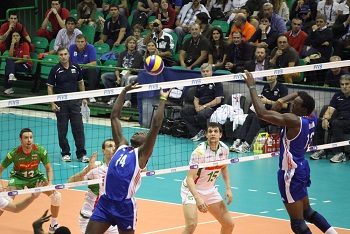Understanding volleyball rotations, where to line up, and when to rotate is essential to playing volleyball.
You must be able to receive the serve to run an effective offense
It’s important for players to understand serve receive formations. Being able to serve receive effectively is necessary in order for a team to run an offense. Basically, if your team can’t effectively pass the ball to the setter, then your setter can’t run an offense.
It’s very important to understand volleyball rotations and every player must understand their role within each rotation.

How to Line Up in Serve Receive
The following are some key points for how to line up to receive a serve…
- You must understand that there are 6 positions on the court. The 6 positions are 1) right back, 2) right front, 3) middle front, 4) left front, 5) left back, and 6) middle back.
- At the moment of service contact, the players that are in positions next to one another and opposite one another can’t be overlapped. If the players are overlapping, the referee can whistle and make an “out of alignment” call. The result of being “out of alignment” is loss of the ball and point for the opponent.
- The positions that can’t overlap with one another are…
RB (RF and MB)
RF (RB and MF)
MF (RF, LF, and MB)
LF (MF, LB)
LB (LF, MB)
MB (MF, LB, RB) - It’s only at the moment of contact when the players need to be in alignment. Before or after the contact, it’s legal for players to be anywhere on the court they desire.
- After the serve, players can move about on the court to any of the volleyball rotations they want. For example, if your middle blocker is in the “left front” position, after the serve they can switch to the middle front.
Volleyball Rotations – Creating a serving order (team line up)
Before the game starts, the coach needs to fill out a line up sheet. The order of players is very important.
Basically, if you have two setters, they need to play opposite each other in the line up.
Same with other positions. For example, middle hitters line up opposite each other. Outside hitters also line up opposite each other.
Back Row Players Take the Pass, Front Row Players Prepare to Spike
This is an example of a team line up…
- Position 1, Setter/Right Side Hitter
- Position 2, Outside Hitter
- Position 3, Middle Hitter
- Position 4, Setter/Right Side Hitter
- Position 5, Outside Hitter
- Position 6, Middle Hitter
Here are some other considerations when creating a line up…
- Do you only have 1 setter? If you only have one setter, then it’s usually best to start the game with the setter on the back row. If the setter is on the back row, you will have 3 attackers at the net. When the setter is on the front row, the setter only has two attackers. Unless your setter is good at attacking the 2nd contact, your offense will likely have more success when the setter is on the back row.
- Have your best server serve first. It’s usually best to have your best server start the game serving. You have to rotate 6 times before you can serve again, so it’s usually better to have your best server serve near the beginning of the game.
- Match up servers and passers. Another strategy for volleyball rotations is to set your line up so that certain servers will serve against certain passers. For example, if you’re playing against a player that has trouble passing a hard topspin serve, and you have a player that can serve really good topspin, then try to match up those players.
- Match up hitters and blockers. If you’re playing against a team that has a hitter that is really good and hard to block, you might try to match up your best blocker with that hitter.
If you enjoyed these tips and would like to keep it close to you at any time, just save this pin to your Pinterest Volleyball Board.

Home › How to Play › Rotations
